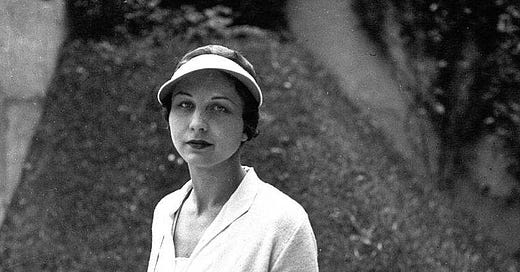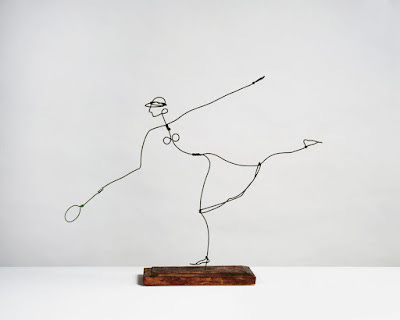#popculture27: Helen Wills Moody Dominates the Tennis World, Inspires Art
The Michael Jordan of tennis in the early twentieth century was this unassuming Californian who also had ties to the art world.
In a Hall of Fame career that spanned two decades, Helen Wills Moody had a pretty good 1927.
The tennis superstar already had two Olympic gold medals on her shelf. But in that year, she won the women’s singles at Wimbledon (the first of four in a row and eight in twelve years) and the US (her fourth in five years), plus the Wimbledon doubles, and began a 180-match win streak.
One could argue that the story of American women athletes in the twentieth century begins with her.
Tennis, anyone?
I probably watched tennis as a kid because it was on TV and it was a sport. In time, I grew to like following the exploits of Andre Agassi, John McEnroe, Martina Navratilova, Steffi Graf and the rest. (I had a bit of a crush on Gabriela Sabatini.) During college, I briefly created a comic strip about pre-teen tennis prodigies—more for myself than anyone else.
In Queens, I lived close to what is now the USTA Billie Jean King National Tennis Center, home of the US Open. Never been there, but I’d see Flushing Meadow Park crowd with spectators—not to mention more parked cars—whenever the US Open started.
As a kid, I might’ve had a few lessons at summer camp or someplace like that, but I never aspired to playing tennis. Watching it was enough.
I would’ve liked to have seen Wills play, though.
Helen Wills at the Olympics
The 1924 Summer Olympics were in Paris. The US won 99 medals, including 45 gold.
California native Wills played tennis from the age of eight and entered her first tournament at thirteen. By 1923 she won the Wightman Cup (the first of six), a women’s tournament, and at seventeen, her first US national championship.
Then came Paris. Her coach at the time was Hazel Hotchkiss, a four-time US champion and founder of the Wightman Cup. She described Wills thus:
Helen was really an unconfident and [socially] awkward girl—you have no idea how awkward…. I thought of Helen as an honestly shy person who was bewildered by how difficult it was to please most people.
Competing with her, Wills won the gold in doubles. She did the same in singles, defeating France’s Julie Vlasto in two sets.
Wills would win the US again, in singles in 1924 and 1925 and mixed doubles in 1924.
But she made Wimbledon her house.
Wimbledon and the US Championships
Wimbledon is the Super Bowl of tennis. Started in 1877 at the All England Lawn Tennis and Croquet Club in London, it’s played outdoors, on grass. It’s the third leg of the Grand Slam of tournaments, including the Australian, French and US Opens.
A 1926 appendectomy made Wills default from the tournament and set her back the rest of that year. The next year, she was the top seed in women’s singles.
In the first round, she lost a set. She would not lose another set in singles until 1933.
She crushed Spain’s Lili de Alvarez in the final, the first of eight Wimbledon singles wins—a record, until Navratilova broke it. Wills also won the women’s doubles title, with Elizabeth Ryan.
Next were more Wightman Cup wins, in singles and doubles, again with Hotchkiss.
The West Side Tennis Club’s Forest Hills Stadium hosted the US championships from 1915-77, also on grass, also here in Queens. These days, it’s a concert venue. A mural in Forest Hills commemorates the site’s history as a place where legends played.
Wills was, again, the top seed. (1927 also saw the tournament institute the seeding system for the first time.) She took down Brit Betty Nuthall for the win.
“Little Miss Poker Face”
They called Wills “Little Miss Poker Face” for her all-business demeanor on the court, in contrast to one of her biggest competitors, France’s Suzanne Lenglen, a more flamboyant athlete. The two only met on a court once, in 1926, a duel hyperbolically known as the “Match of the Century,” a story in itself. Lenglen won in two sets.
In subsequent years, Wills continued winning, despite more injuries and competition from opponents like Helen Jacobs. Decades before King and Bobby Riggs, Wills had her own “Battle of the Sexes” in 1933, defeating Phil Neer.
She retired in 1943 due to, of all things, a dog bite. She died in 1998.
Wills has also been immortalized in the art world.
Wills the muse and artist
Alexander Calder was a sculptor who also did work in painting, printmaking and jewelry. His first solo exhibition was in 1927, in Paris. He made the first of two sculptures of Wills, Expressionist works of “kinetic art,” made of wire and wood. They’re suggestive of contour drawings.
That same year, sculptor Haig Patigian rendered Wills in marble with “Helen of California.”
Other artists would capture her in subsequent years, including, in 1930, none other than Diego Rivera.
Wills also was an artist, an excellent one. In 1928, she wrote a tennis coaching manual and did all the illustrations. The next year, she had an exhibition of her artwork in London. In 1932, her art was part of a competition held during the Olympics in Los Angeles.
She even co-wrote a novel.
A neuroscience institute at UC-Berkeley is named for her.
———
Also in 1927:
Babe Ruth sets a Major League Baseball record with sixty home runs and leads the “Murderer’s Row” squad of New York Yankees to victory in the World Series.
The New York Giants win the NFL championship.
Heavyweight boxing champ Gene Tunney defeats Jack Dempsey in the infamous “long count” match.
Whiskery wins the Kentucky Derby.
The Toronto St. Patricks become the Toronto Maple Leafs.
———
Have you heard of Helen Wills Moody? Leave a comment and let me know!
Share if you liked this post
⬇️






Excellent read